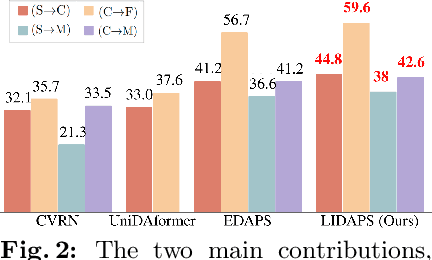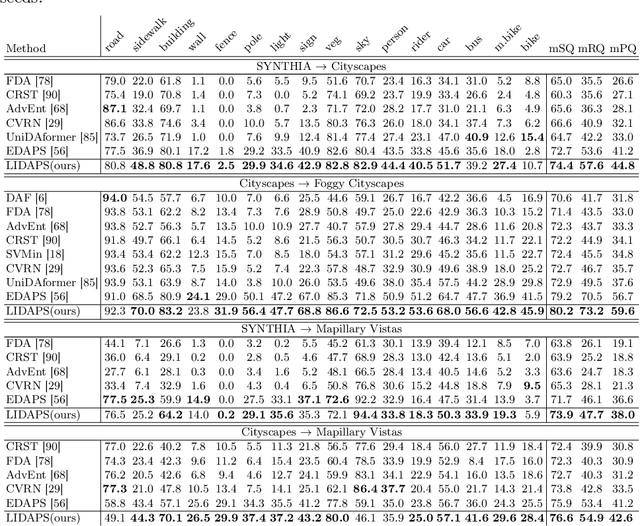Benjamin Bejar
Language-Guided Instance-Aware Domain-Adaptive Panoptic Segmentation
Apr 04, 2024



Abstract:The increasing relevance of panoptic segmentation is tied to the advancements in autonomous driving and AR/VR applications. However, the deployment of such models has been limited due to the expensive nature of dense data annotation, giving rise to unsupervised domain adaptation (UDA). A key challenge in panoptic UDA is reducing the domain gap between a labeled source and an unlabeled target domain while harmonizing the subtasks of semantic and instance segmentation to limit catastrophic interference. While considerable progress has been achieved, existing approaches mainly focus on the adaptation of semantic segmentation. In this work, we focus on incorporating instance-level adaptation via a novel instance-aware cross-domain mixing strategy IMix. IMix significantly enhances the panoptic quality by improving instance segmentation performance. Specifically, we propose inserting high-confidence predicted instances from the target domain onto source images, retaining the exhaustiveness of the resulting pseudo-labels while reducing the injected confirmation bias. Nevertheless, such an enhancement comes at the cost of degraded semantic performance, attributed to catastrophic forgetting. To mitigate this issue, we regularize our semantic branch by employing CLIP-based domain alignment (CDA), exploiting the domain-robustness of natural language prompts. Finally, we present an end-to-end model incorporating these two mechanisms called LIDAPS, achieving state-of-the-art results on all popular panoptic UDA benchmarks.
Semantic-aware Video Representation for Few-shot Action Recognition
Nov 10, 2023



Abstract:Recent work on action recognition leverages 3D features and textual information to achieve state-of-the-art performance. However, most of the current few-shot action recognition methods still rely on 2D frame-level representations, often require additional components to model temporal relations, and employ complex distance functions to achieve accurate alignment of these representations. In addition, existing methods struggle to effectively integrate textual semantics, some resorting to concatenation or addition of textual and visual features, and some using text merely as an additional supervision without truly achieving feature fusion and information transfer from different modalities. In this work, we propose a simple yet effective Semantic-Aware Few-Shot Action Recognition (SAFSAR) model to address these issues. We show that directly leveraging a 3D feature extractor combined with an effective feature-fusion scheme, and a simple cosine similarity for classification can yield better performance without the need of extra components for temporal modeling or complex distance functions. We introduce an innovative scheme to encode the textual semantics into the video representation which adaptively fuses features from text and video, and encourages the visual encoder to extract more semantically consistent features. In this scheme, SAFSAR achieves alignment and fusion in a compact way. Experiments on five challenging few-shot action recognition benchmarks under various settings demonstrate that the proposed SAFSAR model significantly improves the state-of-the-art performance.
 Add to Chrome
Add to Chrome Add to Firefox
Add to Firefox Add to Edge
Add to Edge